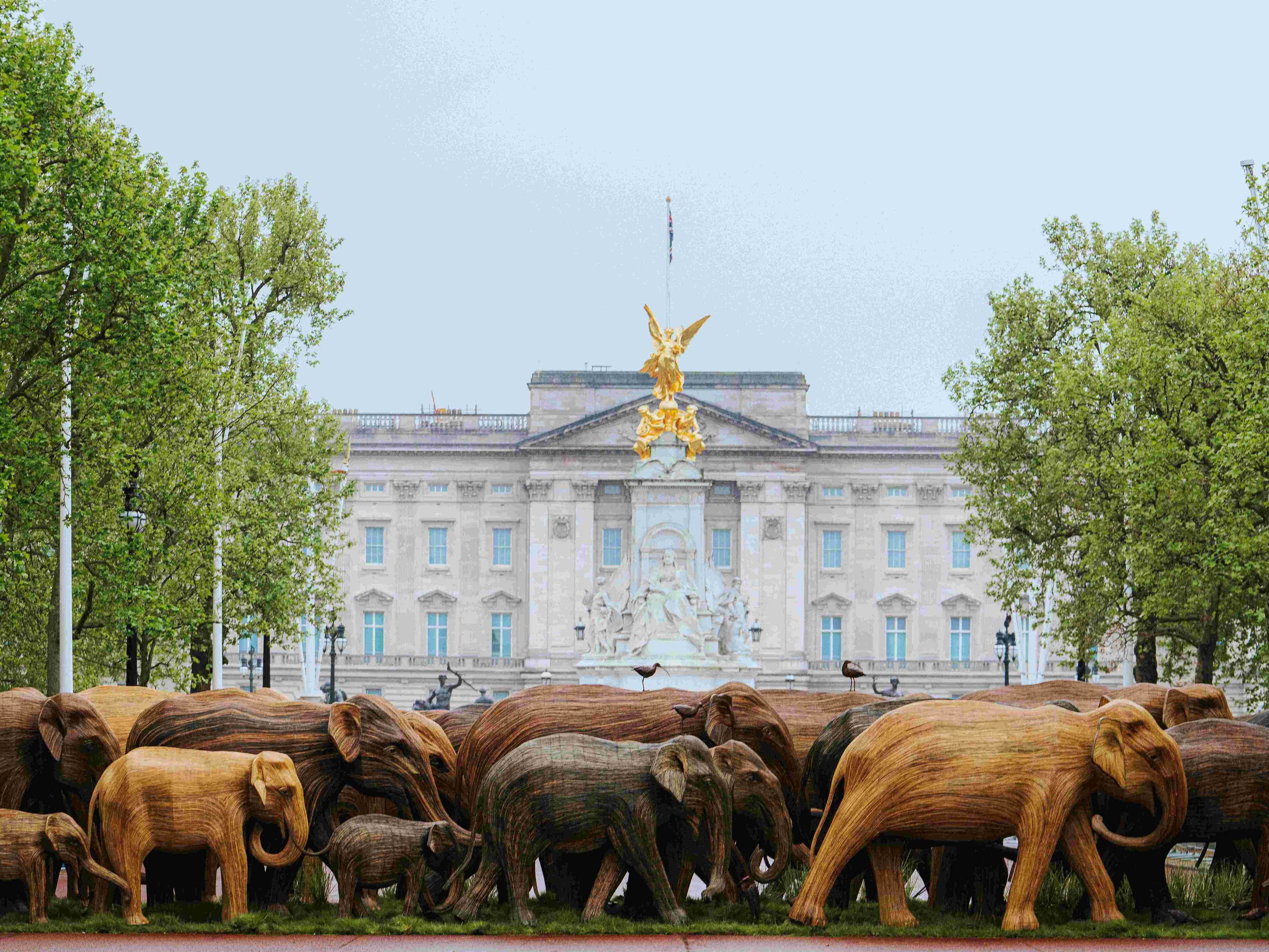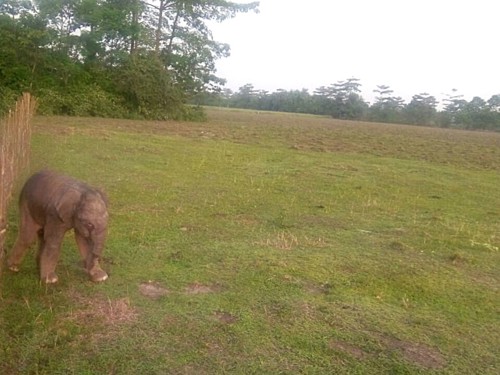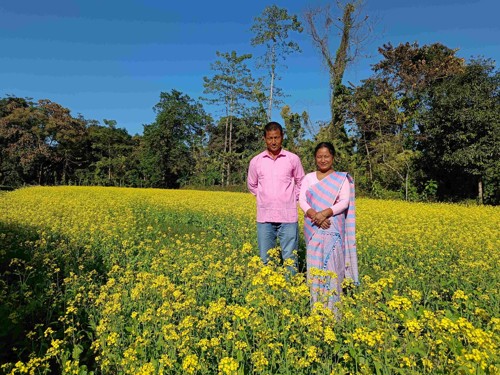Diverse financing for alternative livelihoods

The Coexistence Campaign by Elephant Family comprising a herd of Lantana elephants on The Mall, London. Credit - Grant Walker for Elephant Family.
Bridging the biodiversity financing gap: Blending public and private capital for nature-positive outcomes
When a tiny elephant calf had a misadventure in Assam’s Majuli district, a Rapid Response Unit (RRU) stepped in to ensure the calf was reunited with its herd.
RRUs are an early-warning system of local volunteers who mitigate human-wildlife conflict. They were formed under the project ‘Promotion of coexistence in human-elephant conflict hotspots in Northeast India’, which works in Assam and Meghalaya and is managed by the British Asian Trust with Elephant Family, and implemented by the Assam-based conservation NGO, Aaranyak.
Typically, RRUs let people know when elephants are on the move. This time, they coordinated with the forest department and the village Bonoriya sapori to work out where the calf was stranded and to ensure its safe return to the herd.
The incredible group coordinating this rescue mission was led by their Village Champion, who is a trained volunteer appointed to support our work fostering human-elephant coexistence within individual villages. The effort and time donated by these volunteers relies on building trust and goodwill between our conservation team and the community. Supplying basic field gear such as caps and raincoats to RRUs, and a token honorarium offered to Village Champions, helps the local community see that their time and effort are valued.
These gestures build trust and help mobilise some of the most important stakeholders in conservation; the communities that live alongside the world’s most Endangered and charismatic species. But building this trust costs money, and that money is scarce. The fact is the scale of the conservation challenge dwarfs the scale of funding available through traditional mechanisms.

The challenge - integrating private capital to fund conservation outside protected areas
The global biodiversity financing gap exceeds £500 billion (US$700 billion) per year. Government budgets, philanthropic grants, and international aid are vital, but they cannot fill this gap alone.
In India, significant public funds are allocated towards the management of protected areas. While this is critical, protected areas only comprise 5.3% of India’s land, which means 35% of India’s tiger range, and 70% of Asian elephant ranges, lie outside protected areas and instead in landscapes shared with humans.
As wildlife habitats shrink and degrade, conflict with human beings is emerging as a massive challenge to long-term biodiversity conservation in South Asia. In India alone, increasing human-wildlife conflict (HWC) has claimed over 2,000 human and over 400 elephant lives between 2020 - 2024.
These figures highlight the need to fund other, vital conservation work outside protected areas. Private capital is an important instrument in helping bridge this gap.
The solution - attracting new audiences with innovative fundraising for conservation
The UK government’s Darwin Initiative provides funding for innovative approaches to protecting species, ecosystems, and livelihoods.
We believe the impact of these grants is greatest when projects blend Darwin Initiative funds with private capital, turning small-scale pilots into scalable, long-term solutions. At the British Asian Trust, we raise this capital through an innovative approach to fundraising.
In 2019, the British Asian Trust entered a strategic partnership with Elephant Family, which has raised nearly £22 million for biodiversity since its inception in 2002.
Elephant Family raises awareness and funds through public art campaigns such as The Coexistence Campaign in 2020, which saw over 100 life-size elephant statues made from the invasive plant species Lantana camara being exhibited in London. This campaign raised over £3 million for conservation. More recently, Elephant Family hosted The Big Egg Hunt, a public art trail of egg-sculptures that were auctioned to raise funds in May 2025.
In addition to raising funds, these events create cultural capital around conservation, attracting new audiences of donors, collectors, and luxury brands to create a diverse financing pipeline.
These initiatives have provided much-needed funds to invest in publicly funded programmes, while also enabling us to take risks and build the invisible infrastructure of coexistence, interventions such as community safety measures and livelihood alternatives. These interventions aren't always tangible, which means some funders may not be able to finance them, so private finance can step in to support them.
In 2022, the British Asian Trust secured a Darwin Initiative grant and matched it with its own private funding to foster human-elephant coexistence through safety and livelihood interventions, which included the RRUs and Village Champions mentioned earlier.
Over the last three years, this programme has achieved the following:
- Zero human or elephant deaths due to HWC
- 60% reduction in crop loss and property damage due to HWC
- 100,000+ people reached through education and outreach programmes, fostering human-wildlife coexistence

The next frontier of conservation funding
In addition to using private capital in blended finance to support biodiversity conservation, we are also piloting channelling private finance into social impact bonds. This is similar to how social impact bonds have channelled private capital into human development outcomes.
At the British Asian Trust, we have successfully launched two Development Impact Bonds in skilling and education – one to improve skilling and employment for fifty thousand young people, and the other to equip four million children in India with Foundational Literacy and Numeracy skills.
Other organisations are using similar approaches. Initiatives such as the Rhino Impact Bond, led by United for Wildlife, mobilise private investment for black rhino conservation across Kenya and South Africa.
Pairing these outcomes-based financing mechanisms (those that link financing to the achievement of pre-defined outcomes) with catalytic public funding (i.e. funding that attracts additional investments) such as Darwin Initiative grants, can potentially shift biodiversity finance from short-term grants to sustainable, performance-driven investments. In turn, this may accelerate progress towards global conservation goals.
At a time when up to one million species are threatened with extinction, we invite collaborations to co-create innovative approaches to conservation financing that will help us to protect nature’s extraordinary biodiversity and allow our planet to thrive.
Written by Auro Shashwat and Caroline Abraham (Elephant Family). For more information on this Darwin Initiative Main project 29-018, led by British Asian Trust, please click here.

 Back
Back